Technology on a Slide!
By Tim Palucka
If you are old enough to have used a slide rule, chances are it was a white plastic rectangular device about a foot long with six or more numerical scales, a sliding middle bar, and a clear plastic cursor line that you could use to add subtract, multiply, divide, and perform other mathematical calculations. However, not all slide rules fit this definition, and the tool has come in a surprising number of forms. So what exactly is the slide rule? Learn more about its iterations over the generations.
1960s Slide Ruler

Oone glance at the L. Van V. Dauler, Jr. Historical Calculating Device Collection with its circular, cylindrical, and pocket-size slide rules — including one handheld device that looks like a cross between a pepper grinder and a hand grenade — reveals that rectangular is just one of the many shapes the slide rule has assumed in its 400-year history.
The L. Van V. Dauler, Jr. Historical Calculating Device Collection
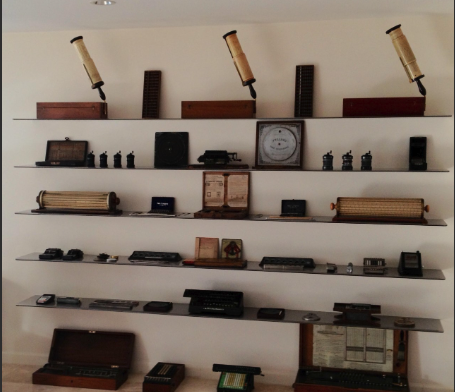
The collection is housed in Pittsburgh and curated by Randi Dauler, widow of the late L. Van V. Dauler, Jr. Van served as Board Chair and CEO of Neville Chemical Company, a privately held company founded in Pittsburgh in 1925 by both of his grandfathers (Edwin Hodge, Jr. and Harvey N. Dauler). Randi has been Board Chair of the company since Van’s death in 2015.
Van’s dual interests in mathematics and science fueled his career choices (management consulting, investment banking, and chemical manufacturing), as well as miscellaneous hobbies and collections.
“Van always wanted a Monroe Calculator, and one day he saw one in the crowded window of a repair shop in the vicinity of the World Trade Center, near where he was working at the time,” Randi recalls. Monroe calculators are hand-cranked mechanical machines first produced in 1912. “The calculator was for sale and fully operational, and that $25 purchase in the mid-80s started Van on a quest to collect antique and unusual calculating devices.”
From that modest start, the collection now fills five long shelves and the floor underneath them in its Pittsburgh location. And, if you think slide rules and calculating machines would make terrible decor, you would be wrong. The collection is a stunning eye-catcher as you enter the room: something unexpected yet intriguing — a piece of arcane history revealed in precision bronze, nickel, chromium, and even magnesium, some devices having mahogany components and white scrolls to make the black numbers more legible. A true conversation starter.
The conversation gets more interesting when you know some of the history of the calculating devices. One was patented in 1880 by an engineer then working at The Keystone Bridge Company in Pittsburgh, who read a paper about his invention before the Engineers’ Society of Western Pennsylvania in 1882. Another calculating device was drawn up in the Buchenwald concentration camp during World War II, and probably saved the inventor’s life.
The Invention of the Slide Rule
Like many origin stories, this one is lost to time. Depending on who you listen to, the slide rule was invented in 1622 by an Anglican minister named William Oughtred, making 2022 the 400th anniversary of its invention, as is claimed by the Oughtred Society, an international society of slide rule enthusiasts and collectors based in California. Or it was invented by Edmund Wingate in 1630, followed by Oughtred’s slide rule in 1632. Numerous other candidates have been put forth over the years, but it seems to come down to these two claims.
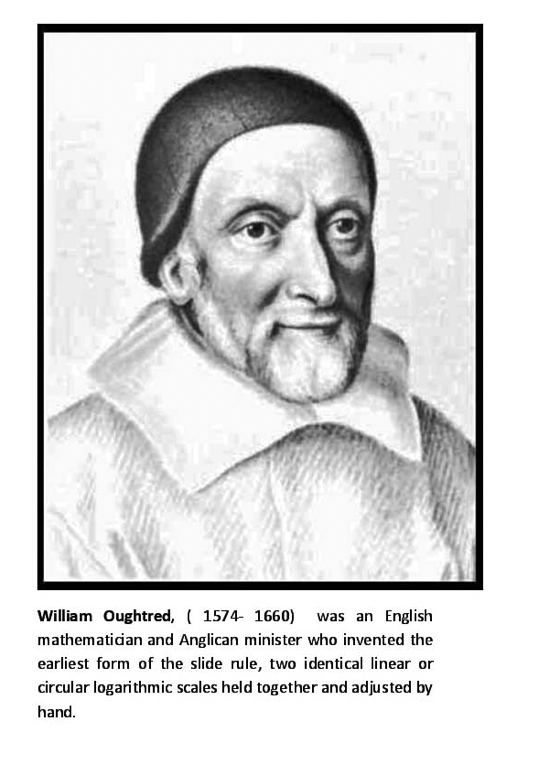
What is known is this: In 1614 John Napier, Baron of Merchiston, Scotland, invented the mathematical concept that made slide rules possible — the logarithm. The logarithm of a number in the commonly used base-10 system is simply the power of 10 which produces the desired number. For instance, 10 raised to the power of 2 yields 100, so the logarithm of 100 is 2.
The logarithm turned out not to be just a mathematical curiosity: it made multiplication and division of large numbers easier. Multiplying two numbers can be done by adding their logarithms; division can be accomplished by subtracting the logarithm of one number from another. So, logarithms made the sometimes difficult tasks of multiplication and long division much easier.
At first, you had to look up the logarithms of the two numbers in a logarithm table, which contains two parallel lists: a column of numbers (call it column A) and a column containing their corresponding logarithms (column B). To multiply two numbers, you would look them up in column A and find their logarithms in column B. You would then add these two logarithms. Next, in a reverse process, you would look up this sum in column B and read the results of the multiplication of the two original numbers in column A.
But reading logarithms from tables is time consuming. In 1620, Edmund Gunter, professor of astronomy at Gresham College, London, put the logarithms from 1 to 10 on a standard ruler, producing what is known as “Gunter’s Scale.” Using a pair of calipers, he could multiply and divide on this scale, but, because it was a single scale with no sliding parts, it was not a “slide” rule. In the question of what a slide ruler is, and where its origin lies, this is certainly a formative step, but it can’t quite be called a slide rule.
Who first developed the idea of placing two of these rules side-by-side and slide one relative to the other to do multiplication and division quickly is still in question. By historians’ standards, publication establishes priority, and Wingate was savvy enough to rush his invention into print in 1630 to stake his claim. Oughtred waited until 1632 to publish details about his slide rule, although documents written by others purport that it was invented as early as 1622.
The Shapes of Slide Rules to Come in the Collection
What is not disputed is that Oughtred developed the first circular slide rule by placing the logarithmic scales on two concentric circular rules and moving them relative to each other to make calculations. In doing so, he started a more than 400-year trend in improving the slide rule’s shape, size, accuracy, and ease of use that only stopped when the digital calculator rapidly replaced slide rules in the 1970s. These developments can be seen by examining a few of the items in the collection.
The Fuller Calculator
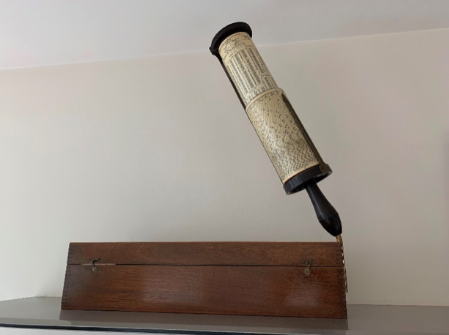
The most eye-catching slide rule in the collection is the Fuller Calculator, or Fuller’s Cylindrical Slide Rule, three of which stand proudly at a 60-degree angle attached to the side of their mahogany cases on the top shelf of the display. Attaching the slide rule to the box was designed “to save the fatigue of holding the instrument in the hand,” according to the operator’s manual. It weighed about 32 oz. (The collection contains operating manuals for most of its slide rules and calculating devices.)
Looking like a one-handled rolling pin, the Fuller Calculator was patented in 1878 by George Fuller, professor of engineering at Queen’s College, Belfast, and manufactured by the W.F. Stanley company in London. It could calculate multiplication, division, proportions, and percentages, and was designed to increase the accuracy of the results of its calculations.
Accuracy was always a point of contention when using slide rules. They were said to produce approximate results based on the skill of the user, the precision of placement of the inscribed numbers, and, most importantly, the length of the logarithmic scale. A longer scale could be marked with more divisions, or tick marks, making the reading of the numbers on the scale more accurate. Accuracy was measured in the number of significant figures in the result of a calculation. Most slide rules of the time were accurate to 3 significant digits.
Obviously, linear slide rules quickly became unwieldy if you tried to extend their scales more than a foot or two. So, Fuller designed his slide rule with a cylinder that is 6 inches high by 3 inches in diameter, “on which is mounted the spiral logarithmic calculating scale which is 500 inches in length,” according to the manual. This extended scale length made calculations accurate to 4 or even 5 significant digits, greatly increasing the confidence of users in their results.
The Fuller Calculator continued to be sold into the 1970s. A full demonstration of how to use one is available on YouTube.
The Curta Calculator – the “Math Grenade” (1947)
Perhaps the most moving of all stories involving the invention of a calculating device is that of the Curta Handheld Mechanical Calculator, conceived in detail by Curt Herzstark prior to World War II and drawn up while he was a prisoner in the Buchenwald concentration camp.

The collection has seven Curta calculators to its name.
“A mathematics teacher introduced me to the Curtas in the late 50's,” Van wrote in 2012 on a website dedicated to the Curta calculator. “I have always wanted one and started accumulating them several years ago on eBay. As you can see, I now have more than the one I originally wanted. They all work perfectly, are in excellent condition and have their metal or plastic cases. One has a leather one as well.” He also comments on “SN 546602, a ‘cutaway’ version showing the inside mechanisms. Works perfectly.”
As reported by Cliff Stoll in his article “The Curious History of the First Pocket Calculator” (Scientific American, Jan. 2004, p. 92), Curt Herzstark was the son of a Catholic mother and Jewish father born in 1902 in Vienna, Austria. The family business sold office machines, and eventually built a factory to manufacture calculating devices. Herzstark got his education in mechanical calculation concepts there, but was bothered by the size of these instruments. The “Millionaire” Calculator, one of which is included in the collection, weighs 60 pounds.
As Stoll reported, Herzstark remarked in an oral history, “Wherever I went, competitors came with wonderful, expensive, big machines. I’d talk with a building foreman, and architect or a customs officer who’d tell me ‘I need a machine that fits in my pocket and can calculate. I can’t travel 10 kilometers to the office just to add a row of numbers.’”
So Herzstark began working on ideas for a mechanical pocket calculator, starting with the user interface. He determined that it had to be a cylinder that would fit in one hand and be operated by the other one. Users would enter numbers using sliders on the side of the cylinder. Turning a crank on the top entered this first number into the calculation, which appeared in the “indicating dial” on top of the cylinder. Then the user would enter the second number using the sliders and turn the crank a specified number of times to affect the mathematical operation; the answer resulting from the addition, subtraction, multiplication, or division of the two numbers would appear on another 11-digit “answering dial” on top of the cylinder.
Herzstark was ready to start manufacturing what would be the Curta Calculator in 1937, when Hitler’s plans interceded. Soon after German troops invaded Austria in 1938, he was manufacturing gauges for Panzer tanks and other precision instruments for the German Army.
Inevitably, he was arrested by the Germans in 1943 after being accused of supporting Jews and was sent to Buchenwald. After an initial, exhausting stint doing manual labor at the camp, an SS officer learned of his technical skills and assigned him to a factory inside Buchenwald, which was manufacturing precision parts for V2 rockets. Herzstark jumped at this opportunity to possibly extend his life.
About two years later, the managing engineer of the factory approached Herzstark and asked about the calculating machine he was rumored to have invented. The deal was that he could draw up the plans and manufacture his calculator in the camp factory. Once he proved it worked, they would present the first one to Hitler in celebration after Germany won the war.
Again, the calculator presented an opportunity to perhaps survive the concentration camp. Herzstark began drawing up the plans from memory.
On April 11, 1945, American soldiers in Jeeps rolled into Buchenwald and liberated the prisoners. Now a free man, Herzstark walked out with his plans in hand. In 1947 the Prince of Liechtenstein, looking to improve the economy of his country, created a company called “Cortina” to manufacture the Curta Calculators, with Hertzark as the technical director holding one-third of the company’s stock. The first 500 units were ready for sale in 1948 for $125.
The miniature calculator, 4 inches high and 2 inches in diameter, with the numbers engraved in magnesium and the calculating cylinders made of steel, looked somewhat like a pepper grinder with its handle and somewhat like a hand grenade, leading William Gibson in his 2003 novel “Pattern Recognition” to call them “math grenades.” The Curta calculator was marketed as “A dwarf in size … A giant in calculating efficiency.” It, too, sold well into the early 1970s, when the last units were manufactured. A demonstration of the Curta in action can be found here.
Thacher’s Calculating Instrument

Undoubtedly the most complex, though still beautiful, looking calculating device in the collection is Thacher’s Calculating Instrument, patented in 1881 when Edwin Thacher was Calculating and Chief Engineer for the Keystone Bridge Co. in Pittsburgh. In its assembled state (upper photograph), the device — constructed of copper alloy, wood, and papier mache — resembles a paddlewheel of a steamboat, with 20 ruled, triangular projections arranged around the circumference of an internal cylinder.
With so many markings on both components, it seems impossible to decipher. When the cylinder is removed from the outer ring of triangles, things become a little clearer: the internal cylinder contains the logarithmic scales, which must be aligned with the markings on one of the triangular scales to perform calculations. The internal cylinder, which resembles a rolling pin, can be moved back and forth to make the alignments possible. Perhaps the need for 20 scales is because of the many types of calculations it could perform: multiplication, division, proportions, powers, squares, square roots, cube roots, multiplication of three numbers together at once (“by one operation”), fractions, and simple interest.
Thatcher was aware of the Fuller Calculator, perhaps because both his calculator and Fuller’s were manufactured by the W.F. Stanley company in London, or perhaps because he made it a habit to know about the latest developments in calculating machines. From the instruction booklet that came with a Thacher calculator, he clearly thought his invention was an improvement on the nearly contemporary Fuller calculator because of the length of the scales (60 feet versus 500 inches for the Fuller device), the method by which the scales were engraved, and the types of materials used:
“In the present instrument … the divisions … are printed directly from machine-divided plates. These plates contain over 33,000 divisions, calculated to seven places of decimals from Babbage’s tables by using a common multiplier, every line being subjected to correction for error of screw and temperature variation. So that possibly every line center is within 0.0001 inch of its true place. The plates contain over 17,000 engraved figures. The work was executed by W.F. Stanley, of London, upon a dividing machine made expressly for this rule, the diamond point used for cutting the divisions being moved by a screw of 50 threads per inch, reading by micrometer to 0.000001 inch. The framework of this rule is of metal throughout, therefore not injuriously affected by variations in temperature nor moisture, no time, pains, or expense having been spared to make the instrument in every way reliable; the scales, being of great length, will give results correctly to four, and usually to five, places of figures, sufficient to satisfy nearly every requirement of the professional and businessman.”
So, by ensuring that the markings on his calculator were done as precisely as possible, and by constructing it of metal, which would not expand or contract as much as a wooden slide rule due to temperature or humidity, Thacher greatly improved the state-of-the-art calculating device.
Being employed in Pittsburgh at the time, Thacher took the opportunity to read a paper about slide rules to the Engineers’ Society of Western Pennsylvania on March 21, 1882. In it, he explained the basic concept of the slide rule and showed examples of an inexpensive flat, rectangular slide rule and Fuller’s device.
Unsurprisingly, toward the end of his presentation, Thacher said: “I will next call your attention to a cylindrical slide rule of my own design. I have here a model for your inspection.”
Compared to Fuller’s spiral layout of logarithms on his scale, “I do not claim for it [the Thacher calculating device] any greater accuracy, but that it has a much wider range, and that results are determined with incomparably greater rapidity,” said Thacher, now assuming his role as salesman.
Perhaps of most interest in the paper are Thacher’s remarks about the limited use of slide rules of any kind at this late date.
“It may be asked by some,” he said,” if the slide rule is an instrument of such vast utility, why, after the lapse of two hundred years, has it not attained a more general use?”
His primary answer was that “no effort has been made to bring it properly before the public, and I think I am correct in stating that there are many, even among engineers, who have never heard of the instrument.”
He concluded his talk by saying: “It is hoped that each of you who are not familiar with the instrument will investigate it for yourself. The time thus spent will never be regretted, and you will soon be able to profitably employ it in the solution of a great variety of useful problems, but whether the object in view be information, recreation, or business application, it will be found well worthy of your attention.”
It is hard to believe that some in this audience of engineers were not familiar with slide rules in 1882, but marketing and communications were much slower and less widespread then.
The Rest of the Collection
The L. Van V. Dauler, Jr., Historical Calculating Device collection consists of approximately 41 slide rules, mechanical calculating machines, and digital calculators. These earliest is a dated 1717 version of Napier’s rods, or Napier’s “bones,” first devised by the inventor of the logarithm, John Napier, and reported in 1617. Each rectangular rod with a square cross section was divided into nine cubic sections, with ten rods making a full set. Though not a “slide” rule by any means, the rods could be arranged by a knowledgeable practitioner to perform multiplication and division.
A 1717 set of Napier’s Bones
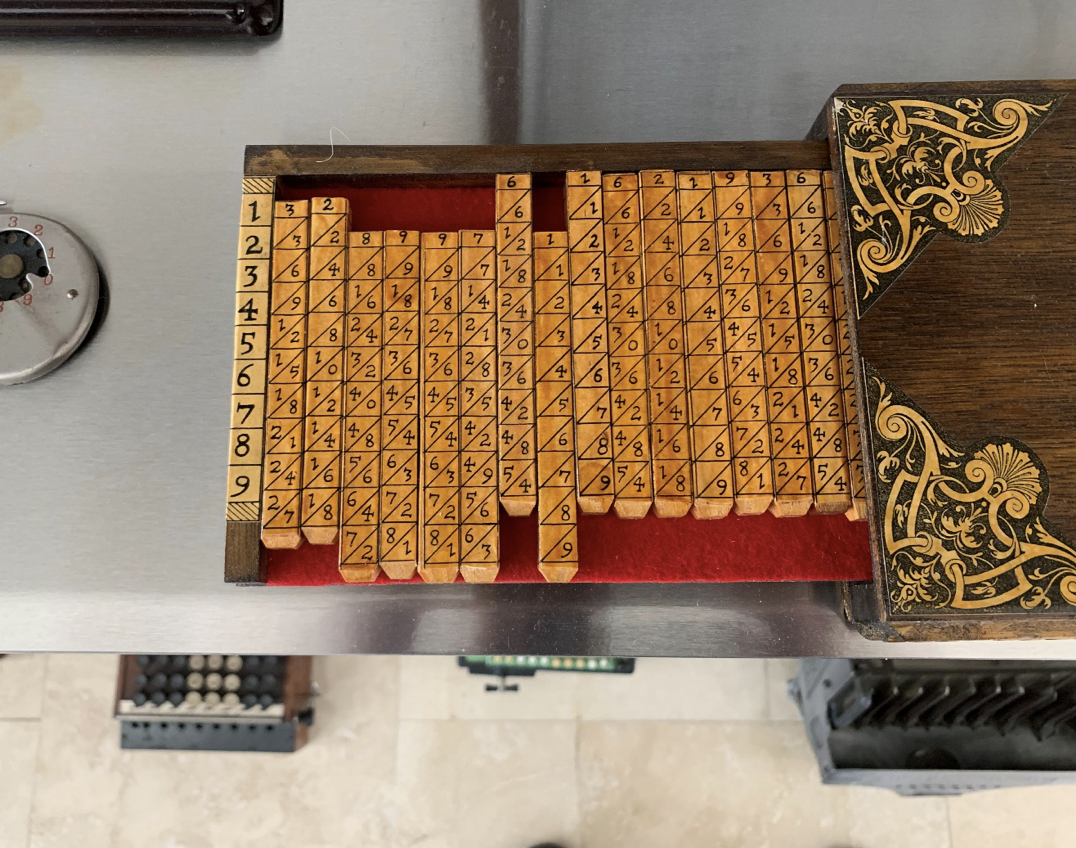
The biggest calculating machine in the collection is the “Millionaire” Calculating Machine (always written with the “Millionaire” in quotation marks), patented in the U.S. by Otto Steiger in 1895 and manufactured by Hans W. Egli of Zurich, Switzerland. According to a brochure, the “Millionaire “is the most efficient calculating machine in the world. Requires only one turn of the crank for each figure in the multiplier. When using other calculating machines, a turn of the crank is required for the number of units represented by each figure comprising the multiplier or quotient.” Because of this, the “Millionaire” machine would not wear out as fast as other mechanical calculators. Also, the brochure states, “The principal advantage in this machine when compared to other systems … consists in the rapidity and simplicity with which multiplications, divisions and compound calculations can be performed.”
The "Millionaire" Calculating Machine
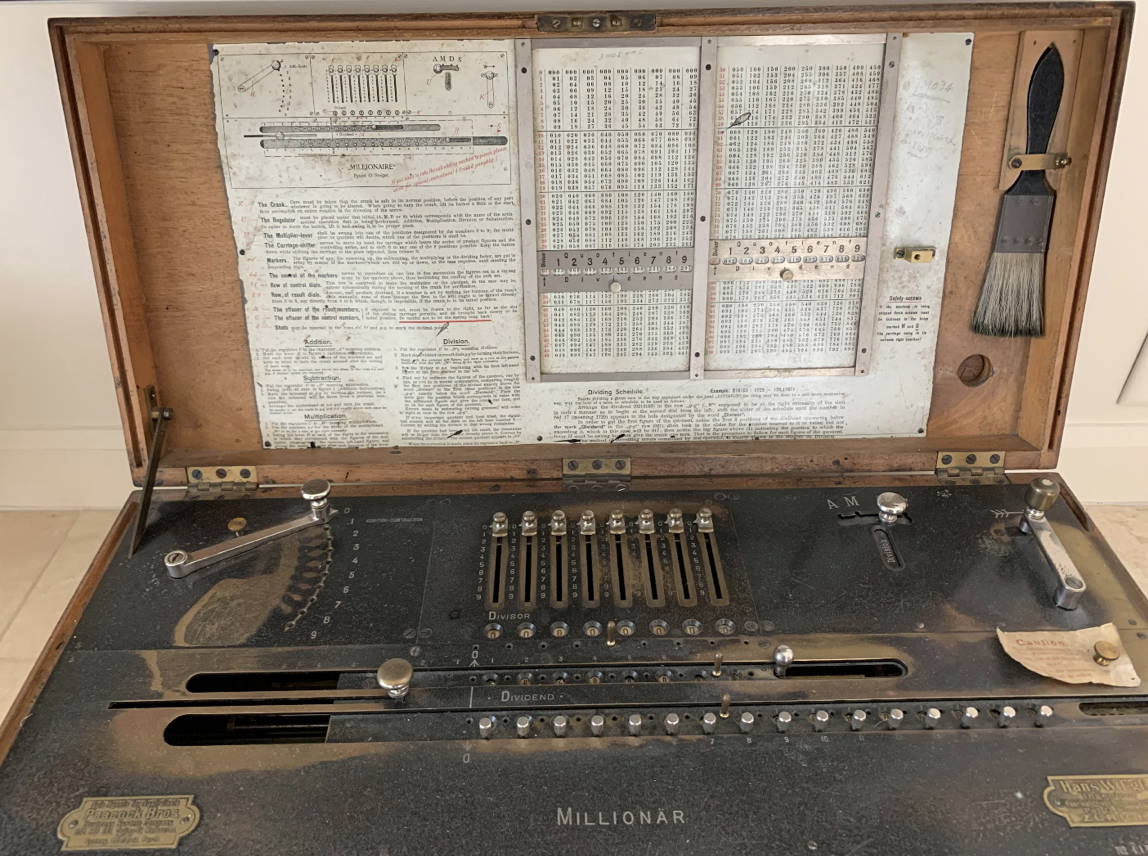
Also in the collection are:
- An 1847 Palmer and Fuller Calculator, with a circular calculating disk in a square wooden frame;
- An 1890s brass and nickel Stephenson Calculator;
- A 1900s Consul Educated Monkey Calculator;
- Two 1903 Addix Calculators;
- A 1904 Archimedes Calculator;
- A 1907 Golden GEM Calculator;
- A 1920 Addometer Calculator;
- A 1921 Addi Cosmos Calculator Adder;
- A 1928 Dayton Friction Adding Calculator;
- A 1961 ALPINA Calculator;
- A “Brunsviga” Calculating Machine (undated);
Consul Educated Monkey Calculator
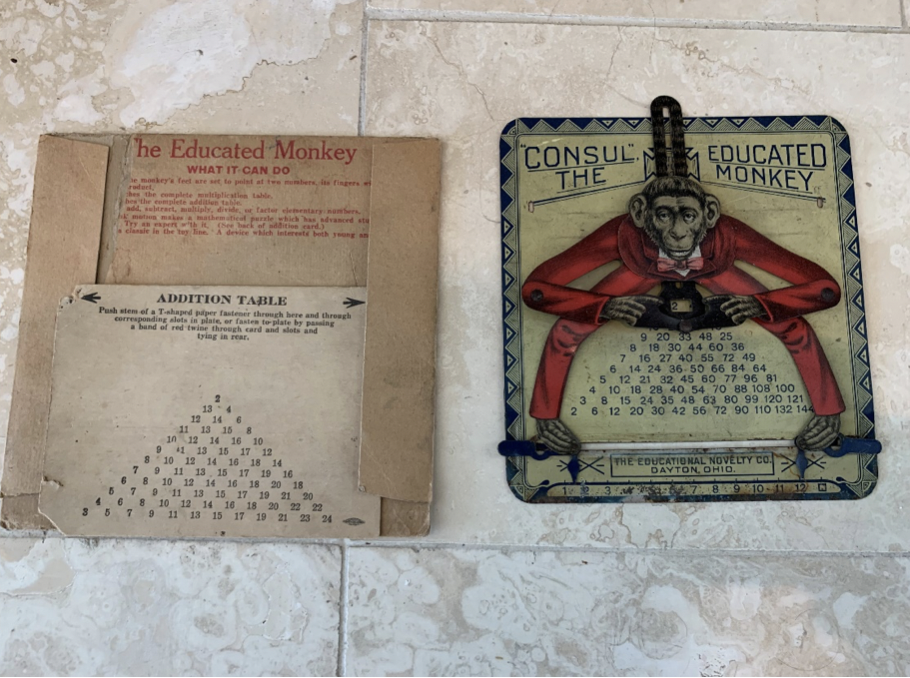
Brunsviga Calculating Machine
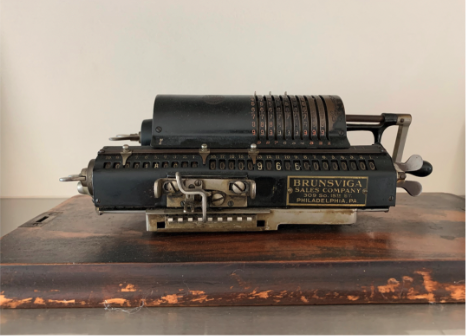
A Fowler’s Vest Pocket Calculator (undated); and
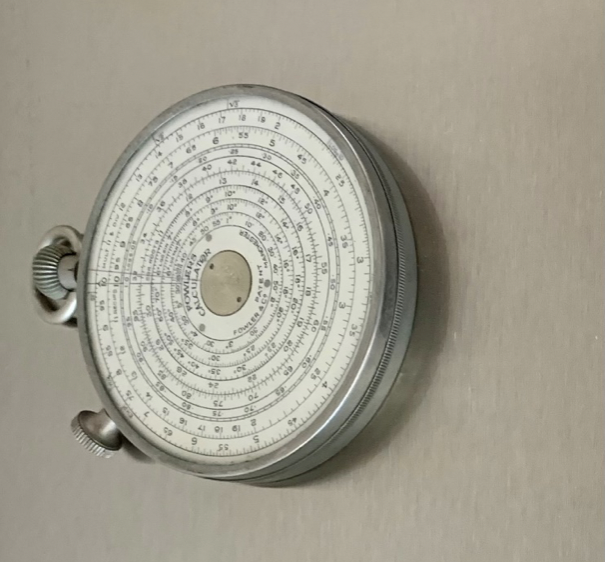
An Otis King handheld cylindrical slide rule (undated).
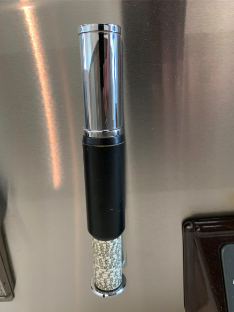
All this in addition to, of course, the Monroe Calculator that started the whole collection.
Taken together, the collection is a tribute to Van’s passion for mathematics and his fascination with calculating devices. It tells a good part of the 400-year history of slide rules and mechanical calculating devices, which may be of value to future historians of science. While many of these blur the line for what is a slide rule, their fascinating story will prove to be an important footnote in the history of scientific and engineering tools.